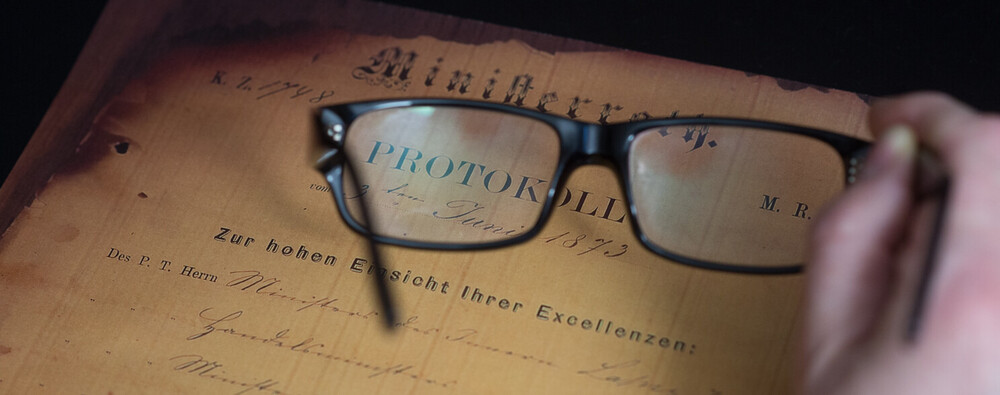Minutes of the Council of Ministers - Habsburg Monarchy
EDITION OF THE MINUTES OF THE COUNCIL OF MINISTERS OF AUSTRIA AND OF THE AUSTRO-HUNGARIAN MONARCHY
Publication of the minutes of the Austrian Council of Ministers was begun by Friedrich Engel-Janosi in 1967, in close cooperation with Hungarian historians. It is a full-text and annotated edition of the original documents kept in the Austrian State Archives (Haus-, Hof und Staatsarchiv and Allgemeines Verwaltungsarchiv) (see Fig. 1). The minutes record the sessions of the Council of Ministers founded in 1848 (1852−1861 the Conference of Ministers) of the Austrian Empire until the Austro-Hungarian Compromise of 1867 (Series 1). The Compromise transformed the Austrian Empire into the Austro-Hungarian Monarchy. Three bodies emerged from the until then unified Council of Ministers: the joint Council of Ministers of the Austro-Hungarian Monarchy 1867–1918 (Series 2), a Council of Ministers for the Kingdom of Hungary and one for the remaining countries, abbreviated as Austria or Cisleithania. The minutes of the latter's sessions will be edited as the minutes of the Cisleithanian Council of Ministers, 1867−1918 (Series 3).
The Council of Ministers was the central body of government. The minutes of its sessions reflect all aspects of political life, from issues concerning the state’s structure and organisation to social, economic and technical developments as well as cultural and social problems. The minutes represent an extraordinary historical source.
All volumes appear both in print and as an online edition.
The Minutes of the Austrian Council of Ministers 1848–1867 (Series 1)
Following a long period of absolute rule, the March Revolution of 1848 opened the way for the development of constitutional government in Austria. The first achievement was the appointment of responsible ministers and a responsible Council of Ministers. This institution remained in place, though with changing fortunes, until the end of the Monarchy. Series 1 of this edition, from the Revolution until the Compromise with Hungary, comprises an introductory volume and six sections containing 27 volumes. The final volume was published in 2015.
The Minutes of the Cisleithanian Council of Ministers 1867–1918 (Series 3)
The edition of the Minutes of the Cisleithanian Council of Ministers spans the half- century from the Austro-Hungarian Compromise of 1867 until the end of the Habsburg Monarchy in November 1918. These minutes were among those badly damaged in the 1927 Palace of Justice fire in Vienna and known as Brandakten (scorched documents, see fig. 2). However, not all the minutes were destroyed. The intact and damaged minutes will be published in an annotated edition including critical comments and supplemented by a complete list of all the sessions and agenda items stemming from the imperial cabinet.
Although the Council of Ministers was now only responsible for 'the kingdoms and lands represented in the Imperial Council', abbreviated as Cisleithania, it remained the central body of government in which structural and organisational issues, economic and social developments as well as cultural and social questions were debated. The interaction of the problems of the territories with those of Cisleithania as a whole was an important topic, including the question of nationalities. The Council also addressed relations with the Kingdom of Hungary.
Project team
Professor Dr Arno Strohmeyer (research unit leader, project leader)
Univ.-Doz. Dr Anatol Schmied-Kowarzik (project leader, co-editor and Series 3 editor)
Dr Franz Adlgasser (co-editor and Series 3 editor)
Dr Wladimir Fischer-Nebmaier (volume editor)
Dr Thomas Kletecka (volume editor)
Dr Klaus Koch (volume editor)
Dr Stephan Kurz, MA (digitisation)
Dr Richard Lein (former researcher, 2018-2022)
Dr Stefan Malfèr (volume editor)
The Minutes of the Joint Council of Ministers of the Austro-Hungarian Monarchy, 1867–1918 (Series 2)
This Council of Ministers discussed joint affairs of the Austro-Hungarian Empire. Its minutes are published by the Hungarian Academy of Sciences.
These minutes also form part of the online edition.


